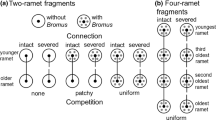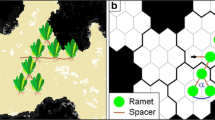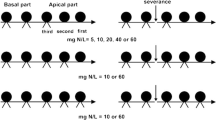Abstract
Many clonal plants are characterised by tussock growth forms, but the mechanisms that account for their formation and maintenance are still vague. Here we examine the possible effects of the recently identified phenomenon of self/non-self discrimination on the spatial distribution and patterning of ramets, tussocks and clones in stands of clonal plants. Spatially explicit ramet-based simulation modeling of growth and competition have shown that compact tussocks can be generated as a transient phenomenon that typically disappears at equilibrium. We introduced self/non-self discrimination into a spatial model by decreasing competition between neighbouring ramets on the same clonal fragment. The results demonstrate that self/non-self discrimination can have significant effects on clonal growth and architecture with a clear tendency to generate long-lasting and self-sustaining clumps. Interestingly, this effect was qualitatively independent of other architectural and growth attributes of the plants, making it a candidate mechanism of stable clumped growth forms observed in many clonal plants and communities. Furthermore, the introduction of self/non-self discrimination shifted competition from the level of ramets to that of clonal fragments, which in turns strongly increased genet extinction rates. Our results stress the need for greater attention to the rather neglected scaling up of physiological and morphogenetical controls to the population and community levels.






Similar content being viewed by others
References
Adachi N, Terashima I, Takahashi M (1996) Mechanisms of central die-back of Reynoutria japonica in the volcanic desert on Mt. Fuji. A stochastic model analysis of rhizome growth. Ann Bot 78:169–179
Bascompte J, Solé RV (eds) (1997) Modeling spatiotemporal dynamics in ecology. Springer, Berlin
Bolker BM, Pacala SW, Neuhauser C (2003) Spatial dynamics in model plant communities: what do we really know? Am Nat 162:135–148
Cain ML (1990) Models of clonal growth in Solidago altissima. J Ecol 78:27–46
Callaway RM, Walker R (1997) Competition and facilitation: a synthetic approach to interactions in plant communities. Ecology 78:1958–1965
Callaway RM, Brooker RW, Choler P, Kikvidze Z, Lortie CJ, Michalet R, Paolini L, Pugnaire FI, Newingham B, Aschehoug ET, Armas C, Kikodze D, Cook BJ (2002) Positive interactions among alpine plants increase with stress. Nature 417:844–848
Chadwick MJ (1960) Nardus stricta L. J Ecol 48:255–267
Choler P, Michalet R, Callaway RM (2001) Facilitation and competition on gradients in alpine plant communities. Ecology 82:3295–3308
Cowie NR, Watkinson AR, Sutherland WJ (1995) Modelling the growth dynamics of the clonal herb Anemone nemorosa L. in an ancient coppice wood. Abstr Bot (Budapest) 19:35–49
Ellner S, Shmida A (1981) Why are adaptations for long-range seed dispersal rare in desert plants. Oecologia 51:133–144
Falik O, Reides P, Gersani M, Novoplansky A (2003) Self/non-self discrimination in roots. J Ecol 91:525–531
Gersani M, Brown JS, O'Brien EE, Maina GM, Abramsky Z (2001) Tragedy of the commons as a result of root competition. J Ecol 89:660–669
Gilad E, von Hardenberg J, Provenzale A, Shachak M, Meron ME (2004) Ecosystem engineers: from pattern formation to habitat creation. Phys Rev Lett 93:98–105
Greig-Smith P, Gemmell AR, Gimingham CH (1947) Tussock formation in Ammophila arenaria (L.) Link. New Phytol 46:262–268
Greig-Smith P (1964) Quantitative Plant Ecology. 2nd Ed. Butterworths Sci. Publs, London
Gruntman M, Novoplansky A (2004) Physiologically mediated self/non-self discrimination in roots. Proc Nat Acad Sci USA 101:3863–3867
Gustafsson C, Ehrlén J (2003) Effects of intraspecific and interspecific density on the demography of a perennial herb, Sanicula europaea. Oikos 100:317–324
Herben T (2004) Physiological integration affects growth form and competitive ability in clonal plants. Evol Ecol 18:493–520
Herben T, Hara T (2003) Spatial pattern formation in plant communities. In: Sekimura T, Noji S, Ueno N, Maini PK (eds) Morphogenesis and pattern formation in biological systems–experiments and models. Springer Verlag, Berlin, pp 223–235
Herben T, Suzuki J (2001) A simulation study of the effects of architectural constraints and resource translocation on population structure and competition in clonal plants. Evol Ecol 15:403–423
Holzapfel C, Alpert P (2003) Root cooperation in a clonal plant: connected strawberries segregate roots. Oecologia 134:72–77
Jones CG, Lawton JH, Shachak M (1997) Positive and negative effects of organisms as physical ecosystem engineers. Ecology 78:1946–1957
Jónsdóttir IS, Augner M, Fagerström T, Persson H, Stenstrom A (2000) Genet age in marginal populations of two clonal Carex species in the Siberian Arctic. Ecography 23:402–412
Kikvidze Z, Pugnaire I, Brooker RW, Choler P, Lortie CJ, Michalet R, Callaway RM (2005) Linking patterns and processes in alpine plant communities: a global study. Ecology 86:1395–1400
Kudoh H, Shibaike H, Takasu H, Whigham DF, Kawano S (1999) Genet structure and determinants of clonal structure in a temperate deciduous woodland herb, Uvularia perfoliata. J Ecol 87:244–257
Law R, Murrell DJ, Dieckmann U (2003) Population growth in space and time: Spatial logistic equations. Ecology 84(1):252–262
Maestre FT, Valladares F, Reynolds J (2005) Is the change of plant-plant interactions with abiotic stress predictable? A meta-analysis of field results in arid environments. J Ecol 93:748–757
Namroud MC, Park A, Tremblay F, Bergeron Y (2005) Clonal and spatial genetic structures of aspen (Populus tremuloides Michx.). Mol Ecol 14:2969–2980
Novoplansky A, Cohen D, Sachs T (1990) How Portulaca seedlings avoid their neighbours. Oecologia (Berlin) 82:490–493
Piqueras J, Klimeš L (1998) Demography and modelling of clonal fragments in the pseudoannual plant Trientalis europaea L. Plant Ecol 136:213–227
Rietkerk M, Boerlijst MC, van Langevelde F, HilleRisLambers R, van de Koppel J, Kumar L, Prins HHT, de Roos AM (2002) Self-organization of vegetation in arid ecosystems. Am Nat 160:524–530
Silvertown J, Holtier S, Johnson J, Dale P (1992) Cellular automaton models of interspecific competition for space - the effect of pattern on process. J Ecol 80:527–534
Suzuki J, Herben T, Krahulec F, Štorchová H, Hara T (2006) Effects of neighbourhood structure and tussock dynamics on genet demography of Festuca rubra in a mountain meadow. J Ecol 94:66–76
Wikberg S, Svensson BM (2003) Ramet demography in a ring-forming clonal sedge. J Ecol 91:847–854
Wildová R, Gough L Herben T, Hershock C, Goldberg DE (2007) Architectural and growth traits differ in effects on performance of clonal plants: an analysis using a field-parameterized simulation model. Oikos 116:836–852
Wilhalm T (1995) A comparative study of clonal fragmentation in tussock-forming grasses. Abstr Bot (Budapest) 19:51–60
Yizhaq H, Gilad E, Meron E (2005) Banded vegetation: biological productivity and resilience. Physica A Statist Mech Appl 356:139–144
Yu FH, Schneller JJ, Krusi B, Schutz M, Tang M, Wildi O (2006) Genetic variability within Carex sempervirens tussocks of contrasting vitality. Int J Plant Sci 167:513–518
Acknowledgements
We thank Jan Wild for drawing maps of spacer structures. The research was supported in part by the GA ČR grants 206/06/0098, 0021620828 and AV0Z60050516 to T.H. and by a research grasnt from the Israel Science Foundation to A.N. This is publication no. 581 of the Mitrani Department of Desert Ecology.
Author information
Authors and Affiliations
Corresponding author
Rights and permissions
About this article
Cite this article
Herben, T., Novoplansky, A. Implications of self/non-self discrimination for spatial patterning of clonal plants. Evol Ecol 22, 337–350 (2008). https://doi.org/10.1007/s10682-007-9214-4
Received:
Accepted:
Published:
Issue Date:
DOI: https://doi.org/10.1007/s10682-007-9214-4




